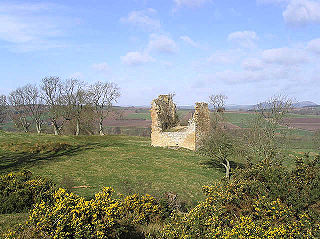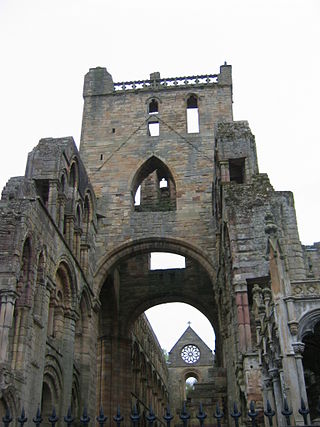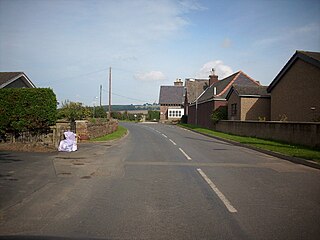Related Research Articles

Jedburgh is a town and former royal burgh in the Scottish Borders and the traditional county town of the historic county of Roxburghshire, the name of which was randomly chosen for Operation Jedburgh in support of the D-Day invasion.
Gary Armstrong is a former Scotland international rugby union player. He played scrum-half for Jed-Forest RFC, Newcastle Falcons and the Border Reivers.

Jed-Forest Rugby Football Club are a rugby union team who are based at Riverside Park in Jedburgh.

Jedburgh Abbey, a ruined Augustinian abbey which was founded in the 12th century, is situated in the town of Jedburgh, in the Scottish Borders 10 miles (16 km) north of the border with England at Carter Bar.

The Jed Water is a river and a tributary of the River Teviot in the Borders region of Scotland.

The Capon Oak Tree is one of the last surviving trees of the ancient Scottish Jedforest. It is close to the A68 and Jed Water, a small river which has cut a course below soft sandstone cliffs. The tree was said to be in the top fifty trees in the UK in 2002.

Jedburgh Castle was a castle at Jedburgh in Scotland. It was fought over during the Wars of Scottish Independence, and was demolished by the Scots commanded by Sir James Douglas of Balvenie in 1409. The site of the original castle was used to build the reform prison based on John Howard system, the construction of which started in 1820.

Timpendean Tower (tim-pen-deen) or Typenden Castle as it was once known, is a ruined 15th-century tower house near Lanton, around 1.5 miles (2.4 km) north-west of Jedburgh in the Scottish Borders.

Lanton is a village in the Scottish Borders area of Scotland, near Jedburgh and Timpendean Tower, off the A698.

The Borders Abbeys Way is a long-distance footpath in the Scottish Borders area of Scotland. It is a circular walkway and is 109 kilometres (68 mi) in length. The theme of the footpath is the ruined Borders abbeys along its way: Kelso Abbey, Jedburgh Abbey, Melrose Abbey and Dryburgh Abbey. These abbeys were homes to monks, who lived there between the 12th and 16th centuries. The route also passes through the towns of Hawick and Selkirk, and close to Abbotsford House, the home of Sir Walter Scott. Along the Borders Abbeys Way there are several rivers: Jed Water, River Teviot, River Tweed, Ale Water, and Rule Water.

Camptown is a small settlement on the A68, in the Scottish Borders area of Scotland, 5m (8 km) south of Jedburgh, and the same distance south to Carter Bar. The village lies on the course of the Jed Water, and the remains of a peel tower are close by at Edgerston.

Bonjedward is a hamlet in the Scottish Borders area of Scotland, two miles north of Jedburgh where the Jed Water joins the River Teviot.

Eckford is a small village located between the larger towns of Kelso and Jedburgh in the Scottish Borders. The village is in close proximity to both the River Teviot and its tributary the Kale Water, and the A698 and the B6401 which run approximately parallel to the respective rivers.
Jedburgh may refer to:

Jed-Forest Sevens is an annual rugby sevens event held by Jed-Forest RFC, in Jedburgh, Scotland. The Jed-Forest Sevens was the fourth of the Border Sevens tournaments to be instated, in 1894, after the Melrose Sevens (1883), Gala Sevens (1884) and the Hawick Sevens (1885).
The Bruce Tree was an oak tree that stood on the grounds of Strathleven House in Dunbartonshire, Scotland. It is reputed to have been planted by Robert the Bruce and was between 700 and 1,000 years old when it fell from an arson attack in May 2004. The timber from the tree was saved and used to form a replica of the Bruce's throne.
The 1898–99 Scottish Districts season is a record of all the rugby union matches for Scotland's district teams.
Fulton Tower is a ruined 16th century tower house, about 4.5 miles (7.2 km) south west of Jedburgh, Scottish Borders, Scotland, and about 2 miles (3.2 km) south of Bedrule, east of the Rule Water.
Bill Purdie was a Scotland international rugby union player.
References
- ↑ "Sessile oak close to River Jedwater in Jedburgh". www.monumentaltrees.com. Retrieved 18 October 2016.
- ↑ Biodiversity Heritage Library (1909), Hound and horn in Jedforest : being some experiences of a Scottish M.F.H., [s.n.], retrieved 20 January 2024